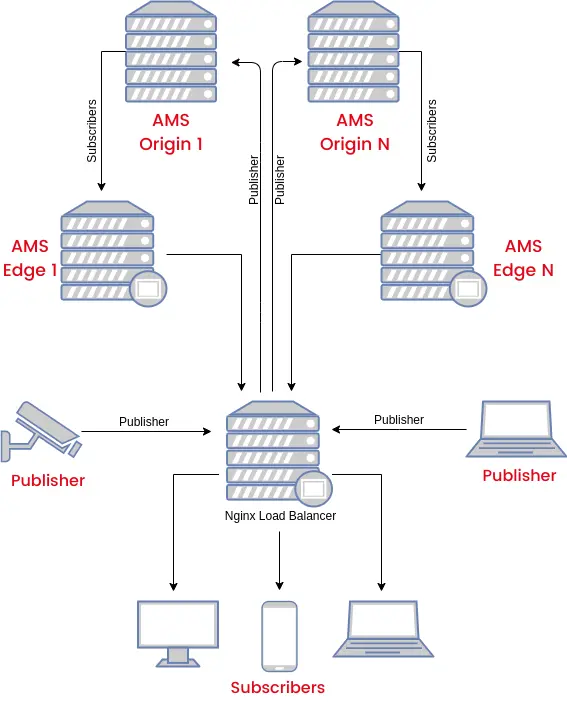Intro
For applications like trivia quizzes, webinars, and conferencing, supporting WebRTC-level sub-second latency for thousands (or even millions) of viewers and broadcasters can be a real challenge. That’s where Ant Media Server cluster mode becomes essential.
Why Cluster Architecture Matters
When a stream is published to a server, viewers typically receive it via TCP or UDP unicast. Scaling beyond single-server capacity becomes impractical—sending the same stream from the broadcaster to multiple servers is inefficient. Instead, you need other nodes to receive, process, and relay streams in real time.
This architecture is especially vital when you use:
- WebRTC: CPU-intensive but necessary for ultra-low latency
- Adaptive Bitrate (ABR): Requires transcoding to match bandwidth and device capabilities—also demanding on processing power
To support high volumes of publishers and viewers while maintaining WebRTC performance and ABR quality, clustering becomes essential.

What Ant Media Server Clustering Delivers
Running in cluster mode means deploying multiple Ant Media Server instances (or “nodes”) that work together seamlessly. A publisher can send a stream to one node, while viewers can watch it from any other node in the cluster. All stream routing and load balancing happen in real time.
Top Benefits:
- Automatic Scaling: Add or remove nodes dynamically to match the load
- Single License, Multiple Nodes: One cluster license can manage all your nodes, no need for individual licenses per instance
- High Availability: Avoid single points of failure and distribute load intelligently
How It Works – High-Level Architecture
- Publish to Origin Node: Broadcasters stream to one or more designated origin servers.
- Stream Propagation: Other cluster nodes replicate the live stream in real time.
- Viewer Access: Viewers connect to the nearest edge node for optimal performance.
- Load Scales Automatically: As demand increases, your cluster can grow to handle more streams and connections.
Advanced Deployments
While you can manually configure a cluster of Ant Media Server instances, most modern use cases benefit from automation and orchestration—especially in large-scale or dynamic environments.
Using Kubernetes for Ant Media Server
Kubernetes provides a powerful platform to orchestrate Ant Media Server clusters. You can deploy, manage, and scale both origin and edge nodes automatically, ensuring high availability and optimized resource usage. Kubernetes helps you:
- Auto-scale based on CPU, memory, or custom metrics (e.g., viewer count or stream load)
- Easily manage rolling updates with minimal downtime
- Ensure high availability across multiple pods or nodes
- Isolate environments (e.g., staging, production) with namespaces
- Monitor health and restart failed containers with built-in probes
Ant Media provides official Helm charts and Kubernetes deployment guides, making it easy to get started. Whether you’re on AWS EKS, Azure AKS, or Google GKE—or even an on-premises cluster—Kubernetes gives you granular control over streaming infrastructure.
Cloud-Native Templates
In addition to Kubernetes, cloud-specific templates like Azure ARM or AWS CloudFormation are available to spin up Ant Media clusters. These templates can:
- Set up origin/edge topology with predefined scaling rules
- Automate SSL setup, domain routing, and stream propagation
- Define autoscaling policies to handle traffic spikes
When to Use Ant Media Server Cluster
Consider clustering when your organization needs:
- WebRTC latency at scale (thousands of concurrent viewers)
- ABR transcoding for dynamic viewer environments
- A fault-tolerant, high-availability streaming infrastructure
- Control over deployment in Kubernetes or cloud environments
- Scalable performance with a single licensing model
Quick Feature Summary
| Feature | Benefit |
|---|---|
| Cluster mode | Scale across multiple servers simultaneously |
| Automatic scaling | Dynamically add/remove nodes based on load |
| Single cluster license | Manage all nodes under one key |
| ABR and WebRTC support | Ideal for low-latency and adaptive streaming use cases |
| API-first and Kubernetes-ready | Integrates smoothly into cloud-native and orchestrated environments |
Final Thoughts
An Ant Media Server cluster provides a robust, scalable foundation for live streaming at scale, especially when ultra-low latency and adaptive bitrate are required. Whether you’re running large webinars, interactive quizzes, or enterprise events, clustering allows you to deliver high-quality, reliable streams efficiently.
If you’d like help setting up a production cluster—or want examples of Kubernetes deployments or Azure or AWS templates—just let us know. We’re here to help you streamline live streaming with confidence.
Estimate Your Streaming Costs
Use our free Cost Calculator to find out how much you can save with Ant Media Server based on your usage.
Open Cost Calculator